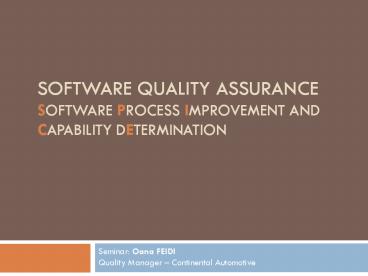Software Quality Assurance Software Process Improvement and Capability DEtermination PowerPoint PPT Presentation
1 / 17
Title: Software Quality Assurance Software Process Improvement and Capability DEtermination
1
Software Quality Assurance Software Process
Improvement and Capability DEtermination
- Seminar Oana FEIDI
- Quality Manager Continental Automotive
2
What is SPICE?
- SPICE Software Process Improvement Capability
dEtermination - also known as ISO/IEC 15504 is an international
standard for SW process assessments - Mainly used in Europe and Australia by the
automotive industry - Goal
- To provide assessment results that are
repeatable, objective, comparable - Future
- Automotive SPICE launched in April 2006
- its usage will increase mainly driven by HIS
(Audi, BMW, Daimler Chrysler, Porsche,
Volkswagen), Ford Volvo, Fiat - Each OEM have different target level if these
are not met, then - Suppliers are requested to improve the
development processes - In case of high risks/low capability levels, the
suppliers are excluded from sourcing
3
The Goal of Process Assessment Improvement
Rating
Process
Assessment
Improvement
- The goal of an improvement is to change an
organizations processes so that they achieve a
higher ability to meet its businesses goals - Assessments deliver the input for any improvement
by detecting strength and weaknesses in the
organizations processes - Assessments are also a tool used by customers to
ascertain the ability of their suppliers to meet
their needs
4
SPICE Models Structure
Processes
- The reference model architecture for this
assessment model is 2-dimensional - Process dimension ? contains processes in groups
- Process Capability dimension ? allows the
capability of each process to be measured
independently
5
SPICE Models Structure
- Process dimension
- Characterized by set of purpose statements which
describe in measurable terms what has to be
achieved in order to attain the defined purpose
of the process - Process Capability dimension
- Characterizes the level of capability that an
organization unit has attained for a particular
process or, - May be used by the organization as a target to be
attained - Represent measurable characteristics necessary to
manage a process and improve its capability to
perform
6
Process structure
7
Process structure
8
Capability Dimension overview
Level 5 Optimizing process
The process performance is optimized to meet
current and future business needs.
Level 4 Predictable process
The process is performed consistently in practice
within defined control limits. The quality of
work products is quantitatively known.
Level 3 Established process
The process is managed and performed using a
defined process. Projects are using a tailored
version of the standard process.
Level 2 Managed process
Base practices of the process are planned and
tracked. Products are conformed to standards and
requirements.
Level 1 Performed process
Base practices of the process are performed ad
hoc and poorly controlled. Work products of the
process are identifiable.
9
Capability Level 1 2
- Level 1
- Level 2
- The purpose of the process is generally achieved
- Work products proof implementation of base
practices - No documented process
- No planning or checks of performance of the
process - No quality requirements for work product are
expressed
- The performance of the process is planned and
checked - The responsibility for developing the work
products is assigned to a person or team - Requirements for the work products are
identified, documented and traced - Work products are put under configuration
management and quality assurance - No documented or defined process
10
Capability Level 3
- A documented standard process with tailoring
guidelines exists and is used in the project - Historical process performance data is gathered
- Experience from the performance of the process is
used for process improvement - Resources and needed infrastructure for the
performance of the process are identified and
made available - The process is not yet quantitatively understood
or managed - Process improvement is reactive
11
Process Dimension overview
- Primary Life Cycle Processes Category
- Acquisition
- Supply
- Engineering ENG.4 (Software requirements
analysis), ENG.5 (Software design), ENG.6
(Software construction), ENG.7 (Software
integration), ENG.8 (Software testing) - Supporting Life Cycle Processes Category
- Support SUP.1 (Quality assurance), SUP.2
(Verification), SUP.8 (Configuration
management), SUP.10 (Change request management) - Organizational Life Cycle Process Category
- Management MAN.3 (Project Management), MAN.5
(Risk Management) - Process Improvement PIM.3 (Process Improvement)
- Reuse REU.2 (Reuse program management)
12
Process Attributes
Level
Attributes
- Process innovation
- Continuous optimization
Level 5
- Process measurement
- Process control
Level 4
- Process definition
- Process deployment
Level 3
- Performance management
- Work product management
Level 2
- Process performance
Level 1
13
Measure capability levels
- The fulfillment of a process attribute (PA) is
measured along a scale from 0 100 in the
following predefined stages - N (not achieved) 0 15
- The are no or only very limited indications of PA
fulfillment - P (partially achieved) 16 50
- There are some indicators that the PA is
implemented to the measured extent. In some
aspects the process remains unpredictable,
though. - L (largely achieved) 51 85
- There is evidence that the PA is implemented to
the measured extend in a useful and systematic
way. Process performance might still show some
weaknesses - F (fully achieved) 86 100
- There is evidence for a complete and systematic
PA execution to the measured extent. Process
performance does not show any significant
shortcomings due to the analyzed processes
14
SPICE Assessments
- Assessment input
- purpose
- scope
- constraints
- qualified assessor
- extended process definition
- Assessment instrument
- process indicators
- process management indicators
Process
Planning
Data collection
Data analysis
Process rating
REPORT
Assessment
- Assessment output
- process capability level ratings
- assessment record
- Process model
- process purpose
- practices
15
SPICE Assessments results
16
Debate
- Lets rate the base practices for ENG.6 (Software
construction) in your organization
SOFTWARE CONSTRUCTION Software implementation
Module/Unit testing
17
Merry Christmas Happy New Year! See you in 2009!

